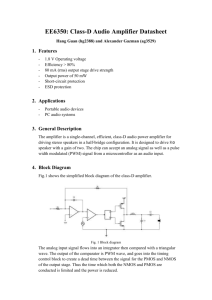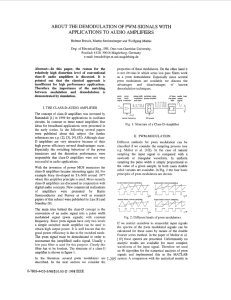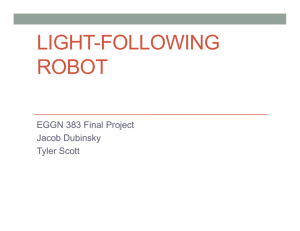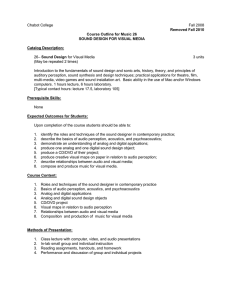a Engineer-to-Engineer Note EE-242
advertisement
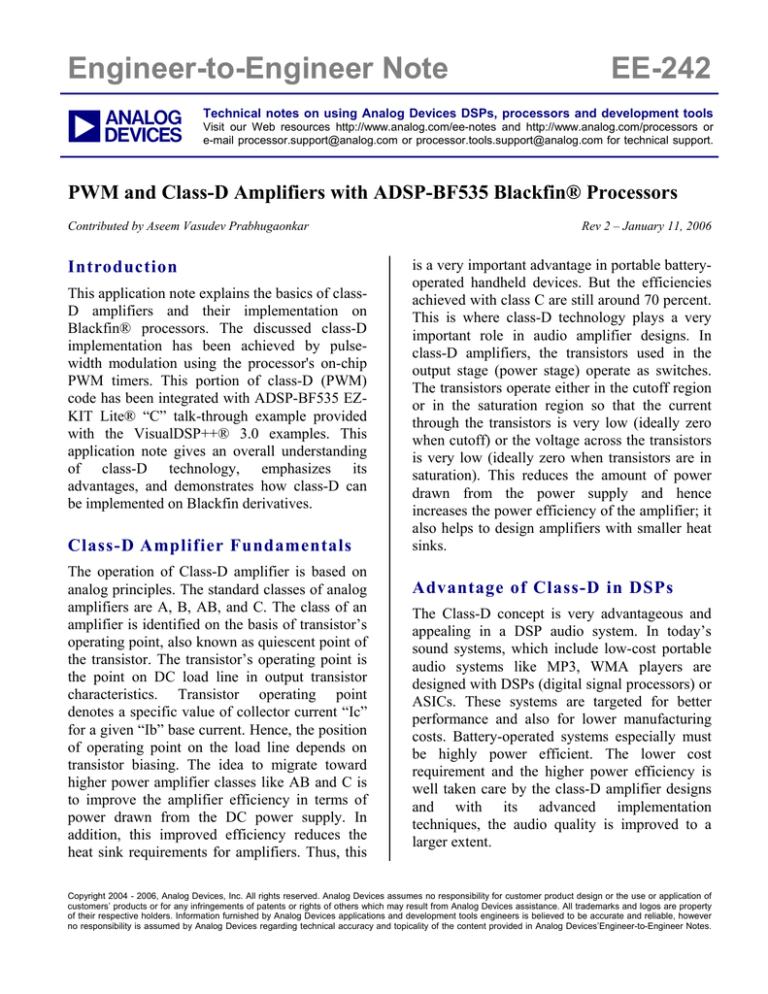
Engineer-to-Engineer Note
a
EE-242
Technical notes on using Analog Devices DSPs, processors and development tools
Visit our Web resources http://www.analog.com/ee-notes and http://www.analog.com/processors or
e-mail processor.support@analog.com or processor.tools.support@analog.com for technical support.
PWM and Class-D Amplifiers with ADSP-BF535 Blackfin® Processors
Contributed by Aseem Vasudev Prabhugaonkar
Introduction
This application note explains the basics of classD amplifiers and their implementation on
Blackfin® processors. The discussed class-D
implementation has been achieved by pulsewidth modulation using the processor's on-chip
PWM timers. This portion of class-D (PWM)
code has been integrated with ADSP-BF535 EZKIT Lite® “C” talk-through example provided
with the VisualDSP++® 3.0 examples. This
application note gives an overall understanding
of class-D technology, emphasizes its
advantages, and demonstrates how class-D can
be implemented on Blackfin derivatives.
Class-D Amplifier Fundamentals
The operation of Class-D amplifier is based on
analog principles. The standard classes of analog
amplifiers are A, B, AB, and C. The class of an
amplifier is identified on the basis of transistor’s
operating point, also known as quiescent point of
the transistor. The transistor’s operating point is
the point on DC load line in output transistor
characteristics. Transistor operating point
denotes a specific value of collector current “Ic”
for a given “Ib” base current. Hence, the position
of operating point on the load line depends on
transistor biasing. The idea to migrate toward
higher power amplifier classes like AB and C is
to improve the amplifier efficiency in terms of
power drawn from the DC power supply. In
addition, this improved efficiency reduces the
heat sink requirements for amplifiers. Thus, this
Rev 2 – January 11, 2006
is a very important advantage in portable batteryoperated handheld devices. But the efficiencies
achieved with class C are still around 70 percent.
This is where class-D technology plays a very
important role in audio amplifier designs. In
class-D amplifiers, the transistors used in the
output stage (power stage) operate as switches.
The transistors operate either in the cutoff region
or in the saturation region so that the current
through the transistors is very low (ideally zero
when cutoff) or the voltage across the transistors
is very low (ideally zero when transistors are in
saturation). This reduces the amount of power
drawn from the power supply and hence
increases the power efficiency of the amplifier; it
also helps to design amplifiers with smaller heat
sinks.
Advantage of Class-D in DSPs
The Class-D concept is very advantageous and
appealing in a DSP audio system. In today’s
sound systems, which include low-cost portable
audio systems like MP3, WMA players are
designed with DSPs (digital signal processors) or
ASICs. These systems are targeted for better
performance and also for lower manufacturing
costs. Battery-operated systems especially must
be highly power efficient. The lower cost
requirement and the higher power efficiency is
well taken care by the class-D amplifier designs
and with its advanced implementation
techniques, the audio quality is improved to a
larger extent.
Copyright 2004 - 2006, Analog Devices, Inc. All rights reserved. Analog Devices assumes no responsibility for customer product design or the use or application of
customers’ products or for any infringements of patents or rights of others which may result from Analog Devices assistance. All trademarks and logos are property
of their respective holders. Information furnished by Analog Devices applications and development tools engineers is believed to be accurate and reliable, however
no responsibility is assumed by Analog Devices regarding technical accuracy and topicality of the content provided in Analog Devices’Engineer-to-Engineer Notes.
a
The digital signal processing systems usually use
codecs or DACs (digital-to-analog converters) to
perform D-to-A conversion of digital audio data
output by the DSP. With class D, the system can
be designed without a codec or a D-to-A
converter, thus reducing the overall system cost.
In addition, the amplifier power efficiency is also
improved to a large extent, which is highly
appreciated in the portable audio market.
Basic Class-D Amplifier
A basic class-D amplifier in the analog domain
consists of three primary units:
A comparator to convert the analog input
signal into PWM output
An H-Bridge, which is the class-D power
amplifier
A filter at the output of the H-Bridge to
reconstruct the analog signal
Figure 1. Class-D Amplifier – Analog Domain
In DSP audio systems, PWM generation
techniques can be implemented in software to
generate the PWM signal for the H-Bridge power
amplifier. The major factors that govern the
performance of such a system are:
The algorithm used to generate PWM output
corresponding to the digital audio signal
The output analog filter stage used to
reconstruct analog audio
Figure 2 shows an oscilloscope screen snapshot
of PWM generated from comparator (blue) and
filtered analog output (pink).
Figure 2. Input Signal, PWM and Filtered Output
PWM and Class-D Amplifiers with ADSP-BF535 Blackfin® Processors (EE-242)
Page 2 of 6
a
Class-D Implementation on the
ADSP-BF535 EZ-KIT Lite
Limitations of the ADSP-BF535
PWM Implementation
In an effort to implement class D with ADSPBF535 processors, timers are used in PWM
mode to generate a PWM signal corresponding to
the digital audio signal. Certain modifications are
carried out in the ADSP-BF535 EZ-KIT Lite
talk-through code for this demonstration. The
audio samples are read by the processor over the
serial port. The amplitude of the audio signal
controls the pulse width of PWM signal. This
effectively generates a PWM signal analogous to
the audio input. The PWM left and right channels
are driven on the TMR0 and TMR1 signal pins,
respectively (refer the ADSP-BF535 EZ-KIT Lite
User’s Manual [1]). The generated PWM is then
fed to an “LC” low-pass filter, which
reconstructs the audio signal. The “LC” low-pass
filter should have a cut-off frequency “fc” of
about 20 KHz.
The PWM implementation in this case is
achieved using the PWM timers of the ADSPBF535 processor. This imposes limitations on the
maximum PWM frequency that can be used and
also on the dynamic range of the audio signal.
These limitations are due to the fact that the
TWIDTH value cannot be more than the TPERIOD
value. Thus, the appropriate value of these two
parameters is a tradeoff between audio signal
resolution and the PWM frequency.
TMR0
Filter
R-ch
TMR1
Filter
L-ch
Class-D Setup with the ADSPBF535 EZ-KIT Lite Board
Figure 3 shows the complete setup with the
ADSP-BF535 EZ-KIT Lite board. An analog
audio signal is fed to the codec on the board. The
PWM signals for the left and right audio
channels are generated on the TMR0 and TMR1
pins, respectively.
BF535 EZKIT Lite
Stereo Headphone
Analog Audio
Figure 3. Class-D Setup with the ADSP-BF535 EZ-KIT Lite Board
PWM and Class-D Amplifiers with ADSP-BF535 Blackfin® Processors (EE-242)
Page 3 of 6
a
Appendix
The PWM code is integrated with talk-through code. The entire project files are available in a ZIP file.
Please see the portion of code, which converts digital audio samples to PWM and drives the TMRx pins
below.
Code Snippet
/*
*
*
*
*
*
*
********************************************************************************
Copyright (c) 2003 Analog Devices Inc. All rights reserved. Please note that
below given is not complete code but just a snippet of code. For complete code
please see the zip file attached.
*******************************************************************************/
#include "BF535 Talkthrough.h"
#include <cdefBF535.h>
#include <signal.h>
//snippet of main function that initializes PWM timers
//*******************************************************************************/
void Init_PWM0(void);
void Init_PWM1(void);
void main(void)
{
Init_PWM0();
Init_PWM1();
Init_Flags();
Init_SPORT0();
Init_Interrupts();
Init_Codec();
while(1)
{
if(sNew_Sample_Received) pSPORT0_RX_ISR_Handling();
}
}
void Init_PWM0(void)
{
*pTIMER0_CONFIG = 0x0019;
*pTIMER0_PERIOD_HI = 0x0000;
*pTIMER0_WIDTH_HI = 0x0000;
*pTIMER0_PERIOD_LO = 0x142;
*pTIMER0_WIDTH_LO = 0xA1;
*pTIMER0_STATUS = 0x0100;
}
void Init_PWM1(void)
{
*pTIMER1_CONFIG = 0x0019;
*pTIMER1_PERIOD_HI = 0x0000;
*pTIMER1_WIDTH_HI = 0x0000;
PWM and Class-D Amplifiers with ADSP-BF535 Blackfin® Processors (EE-242)
Page 4 of 6
a
*pTIMER1_PERIOD_LO = 0x142;
*pTIMER1_WIDTH_LO = 0xA1;
*pTIMER1_STATUS = 0x0400;
}
//*******************************************************************************/
//
//
//
//
The following is a snippet of code which processes the audio samples. The timer
width is modified depending on the amplitude of the input signal. The audio
signal needs sufficient clamping prior to the modification of PWM width. This is
done in order to ensure that the “TWIDTH” is a non-negative and non-zero value.
void Process_Audio_Data(void)
{
unsigned int temp_sLeft_Channel_In;
unsigned int temp_sRight_Channel_In;
//----------------------------------------------------------------------------// code for data processing should be placed here
sAC97_Tag_Out
= sAC97_Tag_In;
sLeft_Channel_Out = sLeft_Channel_In;
sRight_Channel_Out = sRight_Channel_In;
//====================================================
//Process PWM
temp_sLeft_Channel_In = sLeft_Channel_In + 0x7fff;//clamp signal
temp_sLeft_Channel_In = temp_sLeft_Channel_In >> 8; //scale input
*pTIMER0_WIDTH_LO = temp_sLeft_Channel_In;
temp_sRight_Channel_In = sRight_Channel_In + 0x7fff;//clamp signal
temp_sRight_Channel_In = temp_sRight_Channel_In >> 8; //scale input
*pTIMER1_WIDTH_LO = temp_sRight_Channel_In;
// confirm SPORT0 RX interrupt handling
sNew_Sample_Received = 0;
}
Listing 1. Code Snippet
PWM and Class-D Amplifiers with ADSP-BF535 Blackfin® Processors (EE-242)
Page 5 of 6
a
References
[1] ADSP-BF535 EZ-KIT Lite Evaluation System Manual. Revision 2.1, April 2003. Analog Devices, Inc.
[2] ADSP-BF535 talk-through code supplied with VisualDSP++ 3.0, Analog Devices, Inc.
[3] ADSP-BF535 Blackfin Processor Hardware Reference, Revision 2.0, April 2003, Analog Devices, Inc.
[4] A Digital Class D Amplifier Design embodying a novel Sampling Process and Pulse Generator, Huiyun Li, Bah Hwee
Gwee and Joseph S. Chang, School of Electrical and Electronics Engineering, Nanyang Technological University,
Singapore 639798
[5] The Class-D Amplifier, (From the book Introduction to Electroacoustics and Audio Amplifier Design, Second Edition Revised Printing, by W. Marshall Leach, Jr., published by Kendall/Hunt, © 2001.)
Document History
Revision
Description
Rev 2 – January 11, 2006
by Aseem V. Prabhugaonkar
Updated Figure 1, added references [4] and [5]
Rev 1 – September 29, 2004
by Aseem V. Prabhugaonkar
Initial Release
PWM and Class-D Amplifiers with ADSP-BF535 Blackfin® Processors (EE-242)
Page 6 of 6
